A Day in Vincennes, at the Eastern Edge of Paris
Jennifer Ladonne finds Paris’s ‘eastern lung’ is a haven for everyone, from history buffs to birdwatchers to naturists
For most visitors to Paris, a day trip outside the city means braving the lines at Versailles or travelling an hour or more by train or car to Chartres, Fontainebleau, Chantilly or Vaux-le-Vicomte. But relatively few tourists know that a quick 15-minute metro ride from the centre sets you down at the entrance to the Château de Vincennes, in the suburban town of the same name. France’s most impressive and well-preserved medieval fortress, it boasts a stunning Gothic chapel (the precursor and model for Paris’s Sainte-Chapelle), an impressive moat and the tallest castle keep in Europe – once home to some of the country’s most famous kings and notorious prisoners.
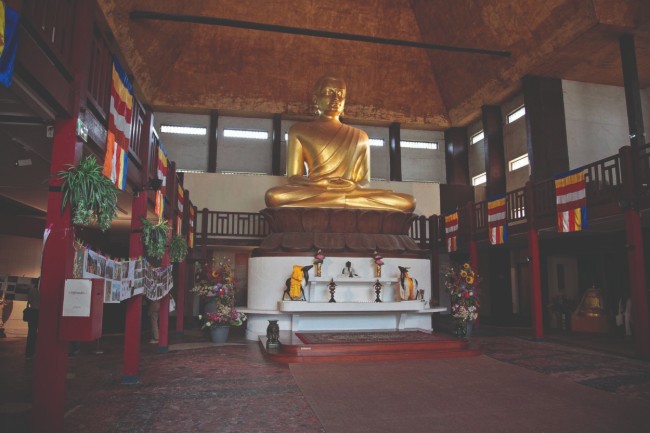
Europe’s largest golden Buddha, located in the Bois de Vincennes. Photo credit: Paris Info
The château alone is an excellent reason to visit Vincennes, but there are a dozen others, such as the lushly wooded Bois de Vincennes, for a start. Nicknamed the ‘eastern lung of Paris’, this public park harbours miles of walking paths through woods and scenic tree-lined lanes, around picturesque lakes and the region’s loveliest garden, the spectacular Parc Floral de Paris. It is also home to the newly-restored Parc Zoologique de Paris, the historic Hippodrome horse racing track and Europe’s largest golden Buddha, which is housed in a giant, thatch-roofed pavilion built for the Paris Colonial Exhibition of 1931.

La Sainte Chapelle du Château de Vincennes. © Patrick Cadet/ CMN
The town itself offers a charming slice of near-Parisian life. The garden squares around the Belle Époque town hall and the wide limestone pavements are lined with lively cafés with sprawling outdoor terraces. Scores of unique boutiques and all the chic French fashion chains are a great way to avoid the Paris bustle (and attitude).
Vincennes is also filled with bakeries, pastry and cheese shops and gourmet grocers. And its colourful outdoor market, offering everything from prepared foods to flowers and organic produce, is held every Tuesday, Friday and Sunday, from 8am to 1pm.
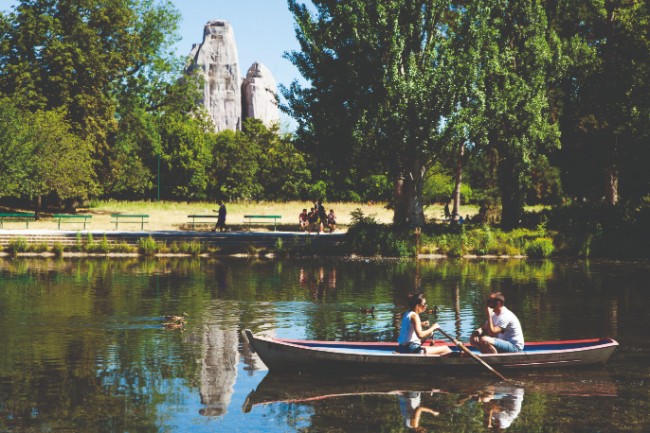
The Bois de Vincennes. Photo credit: Paris Info
BIRTH OF A CITY
Like many a town in France, Vincennes grew out of a château, and like many a great château around Paris – Fontainebleau, Compiègne, Versailles – Vincennes’s got its start as a hunting lodge. Louis VII seized a vast tract of lush forest to the east of Paris for his lodge, which was completed in 1150 and then expanded in 1180 by Philippe Auguste for his royal residence. Several kings later, the 14th-century castle fortress, completed in 1371, contained the first village of Vincennes within its ramparts. The castle remained a royal residence until the 1660s, when Louis XIV moved his court to Versailles.
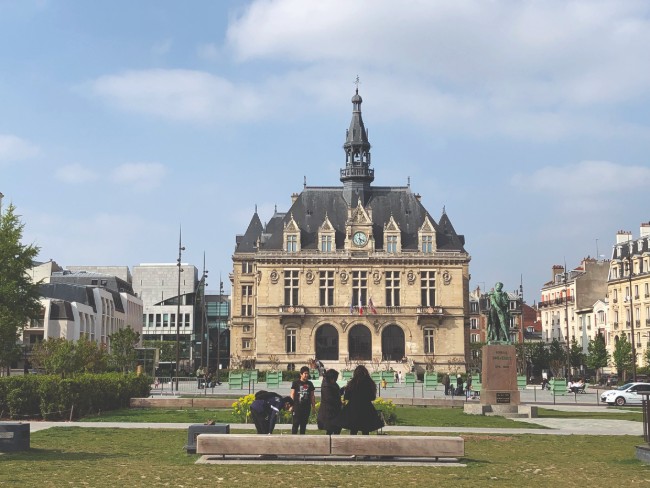
The town hall in Vincennes. Photo: Jennifer Ladonne
After briefly housing the first Sèvres porcelain factory, the château was transformed into a prison, whose illustrious inmates included Enlightenment philosopher Denis Diderot and the Marquis de Sade, who spent seven years here (his cell, no. 6, can be visited) before being locked away in the Bastille. In 1917, Mata Hari, convicted as a German spy, was imprisoned in the château and executed in its deep moat, by then long dry. But the Germans had their bloody revenge, murdering 26 Résistance fighters and police and throwing their bodies in a common grave nearby. The execution site is marked by a contemporary memorial engraved with each fighter’s name and set among a patch of wild flowers.
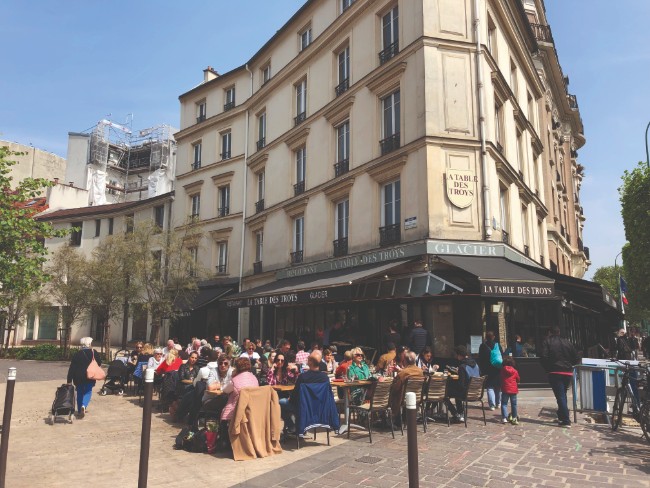
Pavement dining in Vincennes. Photo: Jennifer Ladonne
TWITCHERS AND NUDISTS
Twice the size of the town of Vincennes itself, the highlight of the municipality is, of course, the famous Bois de Vincennes. Covering nearly four square miles, its woods, gardens, fields and lakes feel like a rural idyll far from the city. All but a few of its wide avenues are closed to automobiles and the park is laced with miles of walking paths. An estimated 11 million people a year come here to hike, bike, boat, fish, jog, stroll, picnic, attend open air concerts or visit the zoo. A favourite spot for birdwatchers, the park’s hundreds of visiting and permanent species include kestrels, iridescent kingfishers, pheasants, swans, egrets and herons.
In 2018, Paris finally launched the city’s first naturist area – Espace Naturiste de Paris – where nudists can sun themselves and picnic au naturel from April till October in the heart of the Bois. Just behind the château, the Parc Floral de Paris, 86 acres of rolling hills, grassy fields, and flower gardens, is the capital and its environs’ most beautiful park.
In spring, it’s awash with colour, as hundreds of azaleas and rhododendron bushes bloom alongside Paris’s largest tulip display, with more than 200 varieties. In autumn, the same beds host a ravishing show of dahlias.

Chateau de Vincennes. © Jean-Pierre Delagarde – CMN
Music lovers flock to the Parc Floral in summer for the Paris Jazz Festival, performed in the soaring outdoor amphitheatre. The festival runs for six weekends in June and July and includes a line-up of international jazz greats. You can book a seat under the pavilion or stretch out on the lawn for a picnic under the trees.
Hot on the heels of the Jazz Festival, Classique au Vert, Paris’s summer classical music festival, runs from the first weekend in August until mid- September. If you can’t get to Vincennes to pick up a picnic beforehand, the Parc Floral has a café with seating indoors and out, not to mention a sit-down restaurant.

Sainte-Chapelle de Vincennes. © Caroline Rose – Centre des monuments nationaux
A SPECTACULAR ZOO
Butting up to the Lac Daumesnil, the Parc Zoologique de Paris, which reopened in 2014 after a major six- year renovation, is grouped into five biozones: Madagascar, Guyana, Europe, Sahel-Sudan and Patagonia. Many of the 125 species of animals represented wander free in the open, so you can get an up-close glimpse of giraffes, jaguars, wolves, rhinos, walruses and sea turtles, as well as birds, reptiles and insects. Between the zoo’s two restaurants visitors have the choice of a sit-down lunch or a quick sandwich, salad or pizza. Just the ticket for a pick-me-up before another whirlwind tour of the world’s biozones.
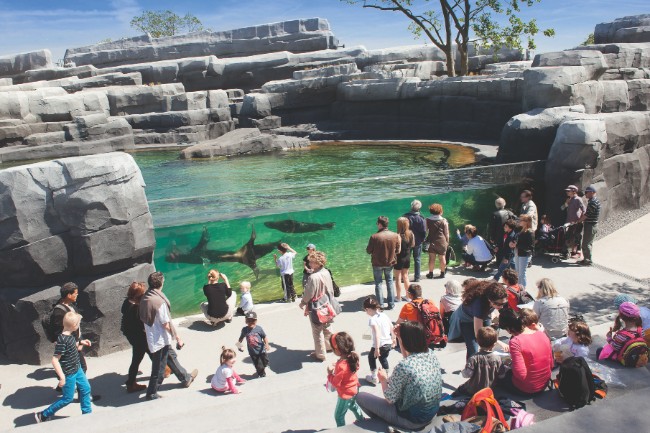
Parc Zoologique de Paris. Photo credit: Paris Info
VINCENNES ESSENTIALS
CLOTHING, TOYS AND MORE
If you’re looking for a jaunty Borsalino or a classic woollen beret, check out the quality handmade hats at Chapellerie Ane Thon (91 rue de Fontenay), along with French espadrilles, shearling slippers and a hand-picked collection of accessories.
Next door, housewares, garden and interiors specialists D’un Jardin à l’Autre (14 rue Lejemptel) carries all those super chic French accessories essential to the French country home. Vincennes is where well-heeled ex-Parisians come to raise their kids, and Sucre d’Orge (8 rue Lejemptel) is the quintessential toy shop, with limited-edition dress-ups, stuffed animals, craft sets, kites and more.

D’un Jardin à l’Autre. Photo: Jennifer Ladonne
Petit Bateau’s classic T-shirts, underwear, raincoats and sweaters, all in durable 100% cotton, never shrink or go out of style. The underwear for kids is the sturdiest and comfiest anywhere. (21-23 rue du Midi)
GOURMET STORES
Des Lis artisanal chocolatier specialises in regular and mint-flavoured dark chocolates, as well as syrups, jam, liqueur, vinegar, sweets made from coquelicot (poppy) and barley sugar candies – the oldest recipe in France, first made by nuns in the 15th century. (2 rue Lejemptel)
Gourmet boutique Chez Valentine (52 rue Raymond du Temple) specialises in French delicacies, from old-fashioned candies, to herbs and spices, teas, tinned fish, condiments and wine.
Opened in 2018, La Fabrique de Confitures (18 rue Lejemptel) has the timeless air of an old candy shop, featuring classic sweets from all regions of France plus caramels, chocolates, handmade biscuits, and dozens of varieties of fruit jams and jellies all made on the premises in the boutique’s open kitchen.
A Meilleur Ouvrier de France and fourth-generation fromager, the selection and expertise at Bruno Collet (19 rue du Midi) rivals any of Paris’s top fromageries. Be sure to ask for what’s in season – some cheeses here have a season that spans only months or weeks.
Paris-based pastry chef Laurent Duchêne, a Maître Ouvrier de France, opened his Vincennes boutique last year and it’s been jam-packed ever since. (45 rue Raymond du Temple)
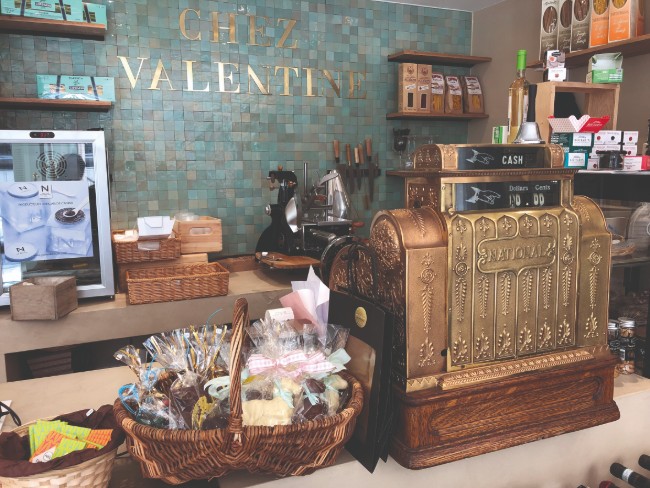
Chez Valentine. Photo: Jennifer Ladonne
Since 1934, the charming corner boulangerie La Flûte Gana has been making fresh breads, brioches, croissants and rustic pastries. A range of fresh sandwiches or goat’s cheese and bacon pizzas are perfect for a picnic in the park. (31 rue Raymond du Temple)
The feather-light cakes, made with meringue-enrobed cream and covered in flakes of chocolate, or crystallised meringue at Aux Merveilleux de Fred are some of the hottest pastries in France. (1 rue du Midi)
Au Potager de Mamie (1 bis rue de l’Eglise) is Vincennes’s most picturesque grocers, selling an impressive variety of fresh organic fruits and vegetables, cheeses, smoked fish, and juices in a teensy space.
Every Tuesday, Friday and Sunday, the outdoor Marché de Vincennes lines the rue de Fontenay.
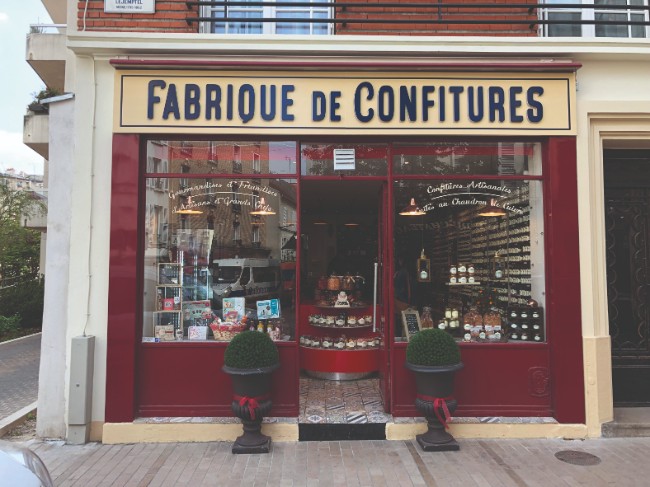
La Fabrique de Confitures. Photo: Jennifer Ladonne
RESTAURANTS AND CAFÉS
The adorable Café Miettes only seats about eight, with more on the outdoor terrace in summer, and is packed at lunchtime, so popular are its salads, sandwiches, pastries and breads, all made on the premises. (87 rue de Fontenay)
As soon as April arrives, Le Marigny’s sprawling outdoor terrace on Vincennes’s prettiest central square is the place to be. Inside, its cosy banquettes are a favourite spot for a long list of French classics. (65 rue de Fontenay)

La Flûte Gana. Photo: Jennifer Ladonne
L’Ours earned a Michelin star within a year of opening. Paris chef Jacky Ribault concocts several menus (there is no à la carte) ranging from €55 to €105, and a three-course menu at lunch (€45,Tues.-Fri.). (10 rue de l’Église)
La Bascule has been around since 1902. Dishes like langoustine in a vegetable bouillon with lemon and coriander oil, or black Baltic beef aged 45 days in beech wood draw an enthusiastic crowd of foodies. (214 rue de Fontenay)
La Table des Troys’s enviable view of the château is a good reason to drop in for a salad and a glass of wine. (2 Bis Avenue de Paris).
From France Today magazine
Share to: Facebook Twitter LinkedIn Email
Leave a reply
Your email address will not be published. Required fields are marked *

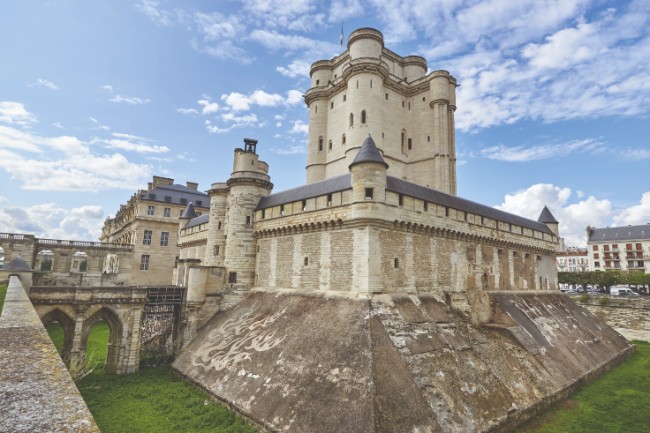




REPLY
REPLY
REPLY